Multi-omics analysis constructs a novel neuroendocrine prostate cancer classifier and classification system
- PMID: 40263498
- PMCID: PMC12015331
- DOI: 10.1038/s41598-025-96683-3
Multi-omics analysis constructs a novel neuroendocrine prostate cancer classifier and classification system
Abstract
Neuroendocrine prostate cancer (NEPC), a subtype of prostate cancer (PCa) with poor prognosis and high heterogeneity, currently lacks accurate markers. This study aims to identify a robust NEPC classifier and provide new perspectives for resolving intra- tumoral heterogeneity. Multi-omics analysis included 19 bulk transcriptomics, 14 single-cell transcriptomics, 1 spatial transcriptomics, 16 published NE signatures and 10 cellular experiments combined with multiple machine learning algorithms to construct a novel NEPC classifier and classification. A comprehensive single-cell atlas of prostate cancer was created from 70 samples, comprising 196,309 cells, among which 9% were identified as NE cells. Within this framework and in combination with bulk transcriptomics, a total of 100 high-quality NE-specific feature genes were identified and differentiated into NEPup sig and NEPdown sig. The random forest (RF) algorithm proved to be the most effective classifier for NEPC, leading to the establishment of the NEP100 model, which demonstrated robust validation across various datasets. In clinical settings, the use of the NEP100 model can greatly improve the diagnostic and prognostic prediction of NEPC. Hierarchical clustering based on NEP100 revealed four distinct NEPC subtypes, designated VR_O, Prol_N, Prol_P, and EMT_Y, each of which presented unique biological characteristics. This allows us to select different targeted therapeutic strategies for different subtypes of phenotypic pathways. Notably, NEP100 expression correlated positively with neuroendocrine differentiation and disease progression, while the VR-NE phenotype dominated by VR_O cells indicated a propensity for treatment resistance. Furthermore, AMIGO2, a component of the NEP100 signature, was associated with chemotherapy resistance and a poor prognosis, indicating that it is a pivotal target for future therapeutic strategies. This study used multi-omics analysis combined with machine learning to construct a novel NEPC classifier and classification system. NEP100 provides a clinically actionable framework for NEPC diagnosis and subtyping.
Keywords: Computational biology and bioinformatics; Multi-omics; Neuroendocrine prostate cancer (NEPC); Tumor biomarkers; Tumor heterogeneity.
© 2025. The Author(s).
Conflict of interest statement
Declarations: All the authors have approved the manuscript and agree with its submission. Competing interests: The authors declare no competing interests. Ethics approval: Patient specimens were collected in accordance with ethical standards set forth in the Declaration of Helsinki, and written informed consent was obtained from all participants. The study was approved by the Ethics Committee of the Fourth Affiliated Hospital of Zhejiang University Medical College, Yiwu, Zhejiang, China.
Figures

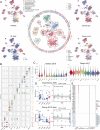
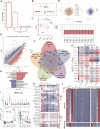
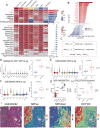
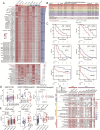
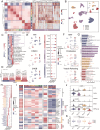

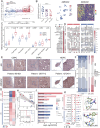
Similar articles
-
Gene expression signatures of neuroendocrine prostate cancer and primary small cell prostatic carcinoma.BMC Cancer. 2017 Nov 13;17(1):759. doi: 10.1186/s12885-017-3729-z. BMC Cancer. 2017. PMID: 29132337 Free PMC article.
-
Identification of Novel Diagnosis Biomarkers for Therapy-Related Neuroendocrine Prostate Cancer.Pathol Oncol Res. 2021 Sep 27;27:1609968. doi: 10.3389/pore.2021.1609968. eCollection 2021. Pathol Oncol Res. 2021. PMID: 34646089 Free PMC article.
-
New insights into markers for distinguishing neuroendocrine prostate cancer: evidence from single-cell analysis.Front Immunol. 2025 Mar 14;16:1551815. doi: 10.3389/fimmu.2025.1551815. eCollection 2025. Front Immunol. 2025. PMID: 40165961 Free PMC article.
-
Unraveling molecular characteristics and tumor microenvironment dynamics of neuroendocrine prostate cancer.J Cancer Res Clin Oncol. 2024 Oct 16;150(10):462. doi: 10.1007/s00432-024-05983-0. J Cancer Res Clin Oncol. 2024. PMID: 39412660 Free PMC article. Review.
-
Molecular mechanisms underlying the development of neuroendocrine prostate cancer.Semin Cancer Biol. 2022 Nov;86(Pt 3):57-68. doi: 10.1016/j.semcancer.2022.05.007. Epub 2022 May 18. Semin Cancer Biol. 2022. PMID: 35597438 Review.
References
-
- Bray, F. et al. Global cancer statistics 2018: GLOBOCAN estimates of incidence and mortality worldwide for 36 cancers in 185 countries. CA Cancer J. Clin.68(6), 394–424 (2018). - PubMed
-
- Liu, S., Alabi, B. R., Yin, Q. & Stoyanova, T. Molecular mechanisms underlying the development of neuroendocrine prostate cancer. Semin. Cancer Biol.86(Pt 3), 57–68 (2022). - PubMed
MeSH terms
Substances
Grants and funding
LinkOut - more resources
Full Text Sources
Medical

